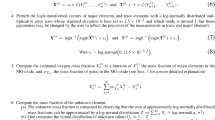Abstract
Computation of phase diagrams in mineral systems and quantitative geothermobarometry thrive on the availability and accuracy of internally consistent thermodynamic datasets for minerals. The prevailing two methodologies applied to derive them, mathematical programming (MAP) and least squares regression (REG), have their very specific advantages and deficiencies which are to some extent complementary. Bayes estimation (BE), the novel technique proposed here for obtaining internally consistent thermodynamic databases, can combine the advantages of both MAP and REG but avoid their drawbacks. It optimally uses the information on thermochemical, thermophysical, and volumetric properties of phases and experimental reaction reverals to refine the thermodynamic data and returns their uncertainties and correlations. Therefore, BE emerges as the method of choice. The theoretical background of BE, and its relation to MAP and REG, is explained. Although BE is conceptually simple, it can be computationally demanding. Fortunately, modern computer technology and new stochastic methods such as Gibbs sampling help surmount those difficulties. The basic ideas behind these methods are explored and recommendations for their use are made using the Al2SiO5 unary as an example. The potential of BE and its future perspective for application to multicomponent-multiphase systems appear very promising. For the convenience of readers not interested in the mathematical details of BE, an illustrative example is given in the Appendix to promote an intuitive understanding of what BE is all about.
Similar content being viewed by others
References
Berman RG (1988) Internally-consistent thermodynamic data for minerals in the system Na2O-K2O-CaO-MgO-FeO-Fe2O3-Al2O3-SiO2-TiO2-H2O-CO2. J Petrol 29:445–522
Berman RG (1991) Thermobarometry using multi-equilibrium calculations: a new technique, with petrological applications. Canad Mineral 29:833–855
Berman RG, Brown TH (1985) Heat capacity of minerals in the system Na2O-K2O-CaO-MgO-FeO-Fe2O3-Al2O3-SiO2-TiO2-H2O-CO2: representation, estimation, and high temperature extrapolation. Contrib Mineral Petrol 89:168–183
Berman RG, Engi M, Greenwood HJ, Brown TH (1986) Derivation of internally consistent thermodynamic data by the technique of mathematicl programming: a review with application to the system MgO-SiO2-H2O. J Petrol 27:1331–1364
Besag J, Green PJ (1993) Spatial statistics and Bayesian computation. J Roy Statist Soc B55:25–37
Box GEP, Tiao GC (1973) Bayesian Inference in Statistical Analysis. Addison-Wesley, Reading, Mass
Chatterjee ND (1990) Applied Mineralogical Thermodynamics: Selected Topics. Springer, Berlin Heidelberg New York
Chatterjee ND, Miller K, Olbricht W (1994) Bayes estimation: a novel approach to derivation of internally consistent thermodynamic data for minerals, their uncertainties, and correlations. Part II. Application. Phys Chem Minerals 21:50–62
Demarest HH, Haselton HT (1981) Error analysis for bracketed phase equilibrium data. Geochim Cosmochim Acta 45:217–224
Dohmann B, Falk M, Lessenich K (1991) The random number generators of the Turbo Pascal family. Comp Statist Data Analysis (Statistical Software Newsletter) 12:129–132
Engi M (1992) Thermodynamic data for minerals: a critical assessment. In: Price GD, Ross NL (eds) The Stability of Minerals. Chapman and Hall, London, pp 267–328
Flournoy N, Tsutakwa RK (eds) (1991) Statistical Multiple Integration. Contemporary Mathematics 115. Am Math Soc, Providence, RI
Gelfand AE, Hills SE, Racine-Poon A, Smith AFM (1990) Illustration of Bayesian inference in normal data models using Gibbs sampling. J Am Statist Assoc 85:972–985
Geman S, Geman D (1984) Stochastic relaxation, Gibbs distributions and the Bayesian restoration of images. IEEE Trans Pattn Anal Mach Intell 6:721–741
Gilks WR, Clayton DJ, Spiegelhalter DJ, Best NG, McNeil AJ, Sharples LD, Kirby AJ (1993) Modelling complexity: Applications of Gibbs sampling in medicine. J Roy Statist Soc B 55:39–52
Gill PE, Murray W, Saunders MA, Wright MH (1983) User's guide for SOL/QPSOL: a FORTRAN package for quadratic programming. Technical Report SOL 83–7, Department of Operations Research, Stanford University, Stanford, California
Holdaway MJ, Mukhopadhyay B (1993) A reevaluation of the stability relations of andalusite: Thermochemical data and phase diagram for the aluminum silicates. Am Mineral 78:298–315
Holland TJB, Powell R (1990) An enlarged and updated internally consistent thermodynamic dataset with uncertainties and correlations: the system K2O-Na2O-CaO-MgO-MnO-FeO-Fe2O3-Al2O3-TiO2-SiO2-C-H2-O2. J Metamorphic Geol 8:89–124
Königsberger E (1991) Improvement of excess parameters from thermodynamic and phase diagram data by a sequential Bayes algorithm. CALPHAD 15:69–78
Königsberger E, Gamsjäger H (1990) Analysis of phase diagrams employing Bayesian excess parameter estimation. Monatsh Chemie 121:119–127
Kohn MJ, Spear FS (1991) Error propagation for barometers: I. Accuracy and precision of experimentally located end-member reactions. Am Mineral 76:128–137
Kolassa JE (1991) Confidence intervals for thermodynamic constants. Geochim Cosmochim Acta 55:3543–3552
Metropolis N, Rosenbluth AW, Rosenbluth MN, Teller AH, Teller E (1953) Equations of state calculations by fast computing machines. J Chem Phys 21:1087–1091
Miller K, Olbricht W, Chatterjee ND (1994) Bayes estimation of internally consistent thermodynamic data for minerals: some computational and programming aspects (in preparation)
Powell R (1985) Geothermometry and geobarometry: a discussion J Geol Soc London 142:29–38
Powell R, Holland T (1993) The applicability of least squares in the extraction of thermodynamic data from experimentally bracketed mineral equilibria. Am Mineral 78:107–112
Powell R, Holland TJB (1985) An internally consistent thermodynamic dataset with uncertainties and correlations: I. Methods and a worked example. J Metamorphic Geol 3:327–342
Ripley BD (1987) Stochastic Simulation. Wiley, New York
Ritov Y (1989) Monte Carlo computation of the mean of a function with convex support. Comp Statist Data Analysis 7:269–277
Robie RA, Hemingway BS, Fisher JR (1979) Thermodynamic properties of minerals and related substances at 298.15 K and 1 bar (105 Pascals) pressure and at higher temperatures. US Geol Surv Bull 1452
Rubinstein RY (1981) Simulation and the Monte Carlo Method. Wiley, New York
Smith AFM (1991) Bayesian computational methods. Phil Trans Roy Soc London A337:369–386
Smith AFM, Roberts GO (1993) Bayesian computation via the Gibbs sampler and related Markov chain Monte Carlo methods. J Roy Statist Soc B55:3–23
Smith RL (1984) Efficient Monte Carlo procedures for generating points uniformly distributed over bounded regions. Operations Res 32:1296–1308
Author information
Authors and Affiliations
Rights and permissions
About this article
Cite this article
Olbricht, W., Chatterjee, N.D. & Miller, K. Bayes estimation: A novel approach to derivation of internally consistent thermodynamic data for minerals, their uncertainties, and correlations. Part I: Theory. Phys Chem Minerals 21, 36–49 (1994). https://doi.org/10.1007/BF00205214
Received:
Revised:
Accepted:
Issue Date:
DOI: https://doi.org/10.1007/BF00205214




